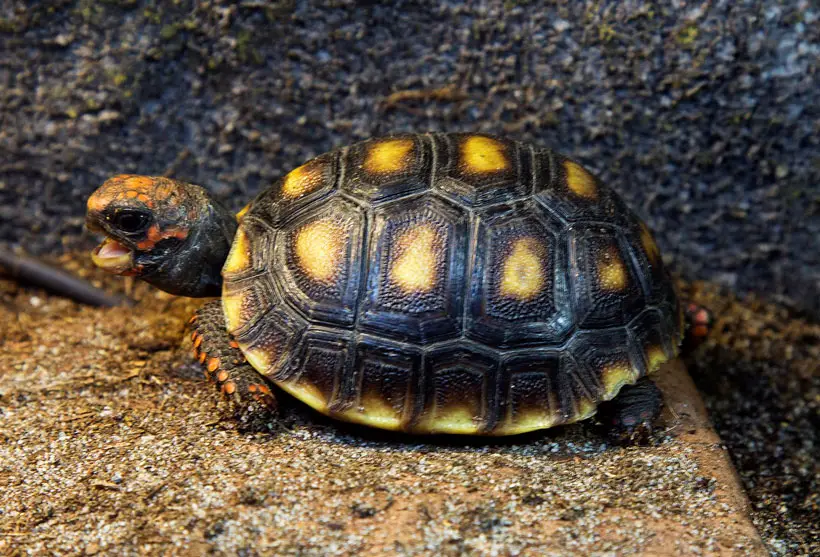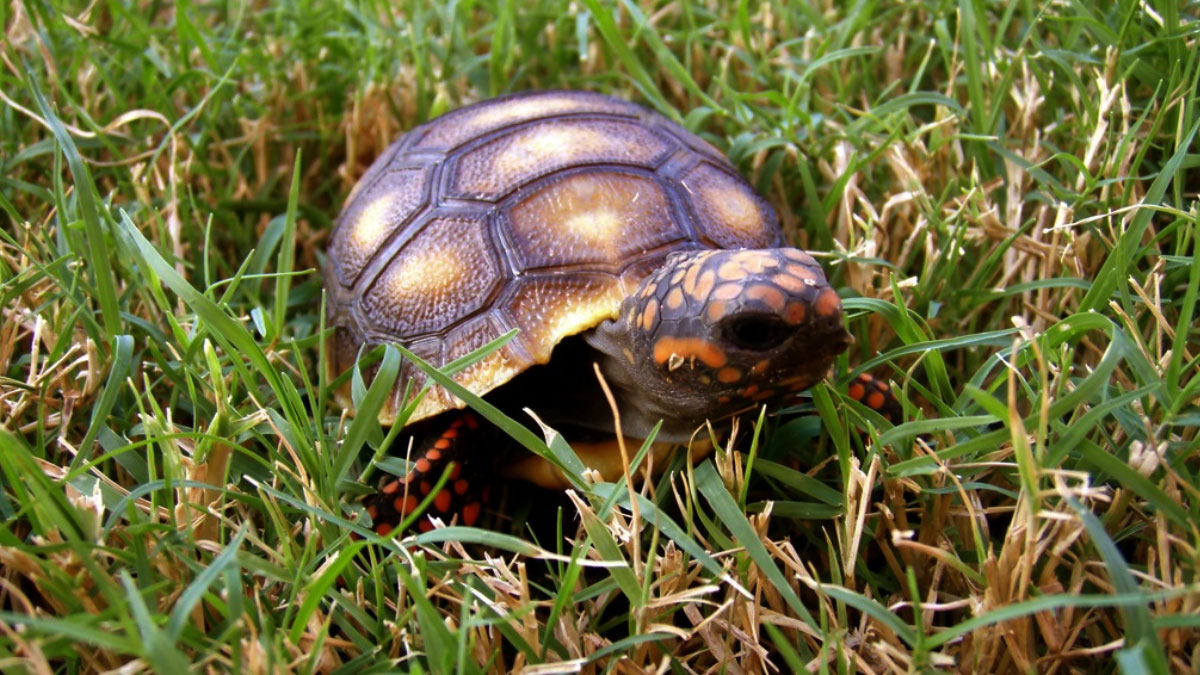Baby Red Foot Tortoise Care: A Comprehensive Guide
Red Foot Tortoises make excellent lifetime pets. It’s best to get them at an early age and care for them. However, you have to properly care for them to grow healthy and meet their life expectancy, around 50 years or more.
So, how do you care for the baby Red Foot tortoise? Provide a warm basking area housing after getting your new baby Red Foot tortoise. Offer multiple hides and secure places. Feed your baby Red Foot tortoise dark, leafy greens and vegetables twice. Schedule health checks every 3-4 months during the first year.
That summarizes the process of caring for a juvenile Red Foot tortoise. Read on to learn everything there is on the topic.
What Is Baby Red Foot Tortoises’ Ideal Environment?
Contents
Baby Red Foots require a basking spot around 90-95°F and nighttime temperatures as low as 70°F. Creating a temperature gradient with a heat lamp or emitter allows the tortoise to self-regulate and select its preferred temperature.

Since Red Foots are tropical tortoises, they require humidity between 70-80%. You need to find a way to keep the housing humid. You can use substrates that hold moisture well, like sphagnum moss, cypress mulch, or a dehumidifier.
Baby tortoises feel most secure when they have places to hide. Include hides from rocks, logs, and terra cotta flower pots. The enclosure should be large enough for the tortoise to exhibit natural behaviors but not so large it cannot locate its food and water.
Cage Size and Bedding Of Baby Red Foot Tortoise
For a baby red foot tortoise, a cage size of around 2 feet by 3 feet is ideal. This provides enough space for the tortoise to move around and express natural behaviors while still being manageable for a young animal. As the tortoise grows, the cage size will need to increase accordingly.

For bedding, coconut fiber husk or shredded aspen wood bedding is best for baby red foot tortoises. These materials hold moisture well to help with humidity regulation, which is important for tortoises. They also absorb waste efficiently and can be spot cleaned regularly. Coconut fiber is a natural material that is safe if accidentally ingested.
Aspen wood shavings are also a good choice because they are natural, absorbent, and gentle on delicate young tortoise skin. For young tortoises, avoid beddings like sand, stones, or gravel, as they can cause impaction if accidentally consumed.
How Do You Handle A Baby Red Foot Tortoise?
Young Red Foot tortoises require gentleness and patience when being handled. Start by holding your baby Red Foot for a few minutes to let it get used to your presence.

Hold your tortoise securely but gently with two hands, supporting its legs and shell. Avoid holding it in a way that suspends it in the air or prevents it from pushing off a surface with its legs. Wash your hands properly to avoid contracting dangerous diseases such as salmonella.
Avoid excessive handling during the first year, as the shell is still soft and developing. Interact with your Red Foot by petting it calmly inside its enclosure or while it walks on your lap.
Feeding Of A Baby Red Foot Tortoise
Proper nutrition in the first year of life sets Red Foots up for robust health and longevity. Young Red Foot tortoises have simple but specific dietary requirements. The staple of their diet should be high-fiber leafy greens low in oxalates like collard greens, carrot tops, and mustard greens.
Offer young Red Foots a fresh mix of two to three different high-fiber greens daily until they are around 6 months to 1 year old. Examples of these greens include;
- turnip greens,
- dandelion greens,
- grape leaves,
- hibiscus leaves, and
- collard greens.
This will boost its shell growth. At this stage, supplement with calcium and vitamin powder to ensure proper shell growth.

In addition to greens, offer young Red Foots fruit 2-3 times per week for moisture and variety. Options like watermelon, berries, and melon are ideal. Avoid citrus and high-sugar fruits. Protein sources like worms, mealworms, and very lean meats should make up no more than 10% of the diet for babies.
Keep the young one hydrated by providing water in a small, shallow container or bowl, something they can soak but not drown in. However, ensure you change the water daily as they may pee or poop inside it.
How often do you feed a baby red-footed tortoise?
A baby red-footed tortoise under 1-year-old should be fed small amounts of food at least twice daily. The general rule is to provide as much fresh food as the baby tortoise will eat in about 10-15 minutes at each feeding.

Bathing And House Cleaning
Young Red Foot tortoises require regular hygiene to maintain a healthy shell and immune system. Clean and disinfect your Red Foot’s enclosure once or twice a week.
Remove poop, uneaten food, and dirty or dried substrates. Replace with fresh, moist substrates, disinfect all surfaces and objects using a dilute bleach solution, and rinse well with water.
Clean bedding and hides after bathing to remove any bacteria or dirt the tortoise picked up during the soak. Bathing frequency can decrease to 2-3 times weekly for adult Red Foots. However, if symptoms of dehydration arise, reintroduce more regular bathing.
Health Checks and Vet Visits
Young Red Foot tortoises are more prone to health issues like upper respiratory infections, so early and regular veterinary care is essential. Schedule an initial wellness exam for your new hatchling or juvenile Red Foot within 1-2 weeks of acquiring it.

During the first year, aim for check-ups every 3-4 months to monitor weight gain and rule out potential issues. Your exotic animal veterinarian will perform a physical exam, take measurements and weigh your Red Foot. They will also likely recommend some initial laboratory tests and radiographs.
Any change in normal patterns could indicate an underlying illness. Signs to watch for include lack of appetite, lethargy, nasal discharge, watery or abnormal stool, overgrown beak or claws, and weight loss. Regular health checks and timely treatment provide your Red Foot the best chance at a long, happy life.
Here is a video explaining how to care for the Red Foot tortoise:
FAQs
Below are the most-asked questions related to the topic that can expand your knowledge about caring for a baby Red Foot tortoise.
Baby Red Foot tortoises grow at a relatively slow but steady pace. In the first year, babies typically grow 1 to 2 inches in shell length and gain 100 to 200 grams in weight.
As they enter their second and third years, their growth rate tends to accelerate slightly to around 2 to 4 inches in shell length and 200 to 400 grams of weight gained annually.
Hatchling tortoises typically measure two inches long and weigh two ounces, growing 1–2 inches per year. Males are distinguishable from females because they are usually larger in size, and have a more indented shell with a longer tail.
Conclusion
Proper young Red Foot tortoise care focuses on establishing the ideal environment and implementing basic but essential routines. You also need to closely monitor the little one’s health during the juvenile stage. Feed small amounts of leafy greens and vegetables combined daily. Adequate heating, high humidity, and sufficient hides set the stage for reliable growth and development.
With consistency and attentiveness, your baby Red Foot tortoises will have the best chances of maturing into healthy, long-lived pets. Establishing good habits and addressing health issues promptly from a young age will reward caretakers with many years of joy with their tortoises.

